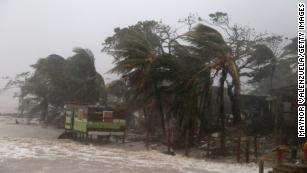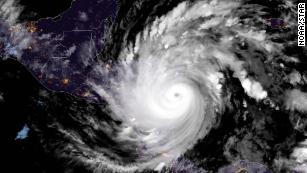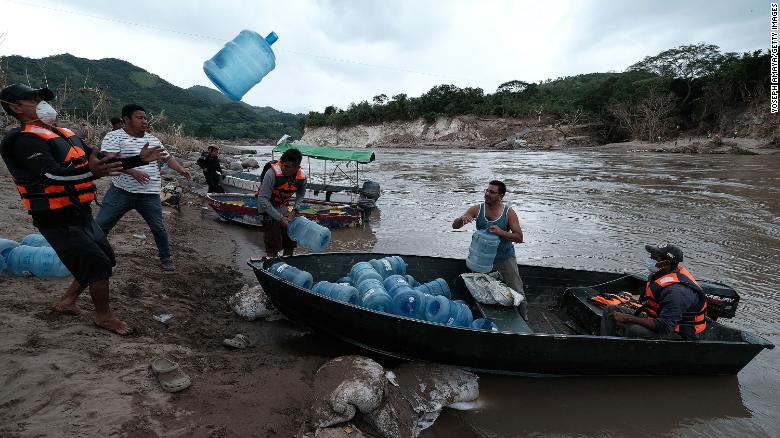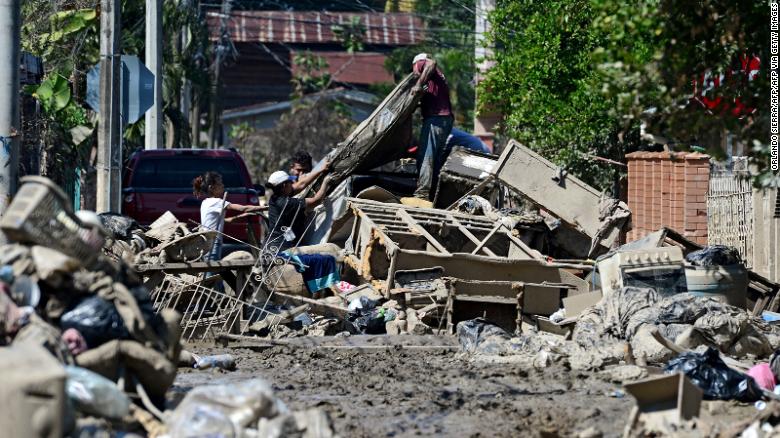Iota downgraded to tropical storm after delivering catastrophic conditions to the coast where Eta struck
By Madeline Holcombe, Amir Vera and Eliott C. McLaughlin, CNN

(CNN) Iota is now a tropical storm, but the Tuesday afternoon downgrade will do nothing to minimize the devastation it brought when it barreled into a Central America still recovering from Eta on Tuesday.As a hurricane, it reached Category 5 strength before making landfall near Haulover, Nicaragua, as a Category 4, with maximum sustained winds near 155 mph, according to the National Hurricane Center.It weakened significantly upon making landfall, but not before delivering the possibility of life-threatening flooding, catastrophic winds and mudslides to huge swaths of Central America.

Help Central America hurricane victimsSwells from the storm will be felt as far north as the Yucatán Peninsula, as far east as Jamaica and as far south as Colombia. Its landfall was just 15 miles south of where Hurricane Eta struck, potentially leaving the region scarred for generations.No deaths were reported in Nicaragua as of late Tuesday morning, according to the country’s disaster management agency. In several cities in the Rivas region, a strip of land between Lake Nicaragua and the Pacific Ocean in the nation’s southwest, authorities are monitoring rivers and placing vulnerable families in shelters, the agency said.How to helpPhotos from the agency show people wading through knee-high water in Rivas and in Bilwi, on the northern coast. Residents of Bilwi, where telecommunications have been impacted, were asked to “maintain calm, stay away from places that are vulnerable or that represent some danger to human security.”
30 inches of rain forecast in some locales
Still packing winds of 65 mph as of 1 p.m. ET, the storm was in northern Nicaragua, about 105 miles east of Tegucigalpa, the Honduran capital, the hurricane center said.

Hurricane Iota makes landfall as a Category 4 stormIt will continue inland into Nicaragua on Tuesday afternoon before moving into southern Honduras late Tuesday. Iota should dissipate near El Salvador by Wednesday night, the center said.The storm has dumped heavy rain, with Honduras and large portions of Nicaragua, Guatemala and Belize expecting at least 10 inches and up to 30 inches through Thursday, while areas from El Salvador to Panama can expect 4 to 8, with isolated maximums of 12 inches.”This rainfall will lead to significant, life-threatening flash flooding and river flooding, along with mudslides in areas of higher terrain,” the hurricane center said in its 1 p.m. alert.”Swells generated by Iota will affect much of the coast of Central America and the Yucatan Peninsula during the next day or so. These swells are likely to cause life-threatening surf and rip current conditions.”
Colombian Islands feel the first impacts
Before reaching Nicaragua, the hurricane became the first of its strength to strike the Colombian Islands of San Andres and Providencia in recorded history, Colombia President Ivan Duque said Monday.San Andres and Providencia have been part of Colombia for centuries but are geographically closer to Central America than to the Colombian mainland. People from San Rafael colony in Honduras prepare for the water shortage as they cross the Ulua River to evacuate Monday.At least one person is dead on Providencia, and 90% of the island’s infrastructure has been affected by Iota, Duque said. The local airport is also unusable because of debris.”It’s the first time that a Category 5 hurricane has reached our territory since records began,” Duque said from Bogota. “We are facing an issue with characteristics never before witnessed by our country.”
People from San Rafael colony in Honduras prepare for the water shortage as they cross the Ulua River to evacuate Monday.At least one person is dead on Providencia, and 90% of the island’s infrastructure has been affected by Iota, Duque said. The local airport is also unusable because of debris.”It’s the first time that a Category 5 hurricane has reached our territory since records began,” Duque said from Bogota. “We are facing an issue with characteristics never before witnessed by our country.”
Central America still recovering from Eta
Iota will be the second major hurricane to hit the area in as many weeks. On November 3, Hurricane Eta made landfall as a Category 4 storm, causing landslides and flooding that displaced thousands and left scores of people dead or missing.It is the 13th hurricane of the 2020 Atlantic hurricane season, a historic season bringing 30 named storms — the most ever. This is the latest in the year there has ever been a Category 5 hurricane in the Atlantic Basin, according to the hurricane center. People try to recover belongings amid mud after the passage of Hurricane Eta as they prepare to evacuate the Omonita neighborhood in El Progreso, Yoro department, Honduras.More than 3.6 million people across Central America have been affected by the storm to varying degrees, the Red Cross said earlier this week.While the full extent of the damage from Eta won’t be known for a while, the powerful storm, combined with the coronavirus pandemic, may have effects that last for years.The storm hovered for days over Nicaragua, Honduras and Guatemala, with heavy rains creating flooding and landslides that wiped out entire communities.Dozens of people in the remote Guatemalan village of San Cristobal remain missing after a landslide swept through last week, leaving mud 50 feet deep in some places.
People try to recover belongings amid mud after the passage of Hurricane Eta as they prepare to evacuate the Omonita neighborhood in El Progreso, Yoro department, Honduras.More than 3.6 million people across Central America have been affected by the storm to varying degrees, the Red Cross said earlier this week.While the full extent of the damage from Eta won’t be known for a while, the powerful storm, combined with the coronavirus pandemic, may have effects that last for years.The storm hovered for days over Nicaragua, Honduras and Guatemala, with heavy rains creating flooding and landslides that wiped out entire communities.Dozens of people in the remote Guatemalan village of San Cristobal remain missing after a landslide swept through last week, leaving mud 50 feet deep in some places.
CNN’s Hollie Silverman, Gene Norman and Robert Shackelford contributed to this report.
For more on this story go to CNN





